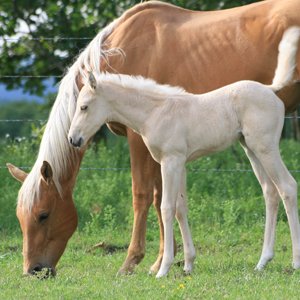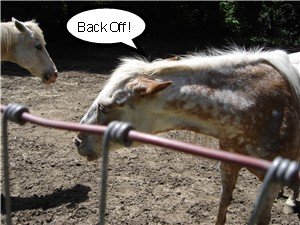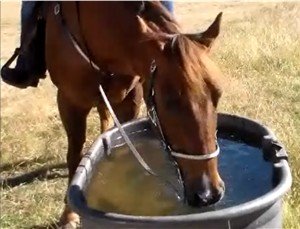Horseback Trail Riding Tips
These horseback trail riding tips will help you deal with obstacles that are not seen in the arena. Rugged ever changing terrain, water, bridges, brush, holes, wildlife, dirt bikes……and on and on it goes. One thing for sure, it’s never boring!
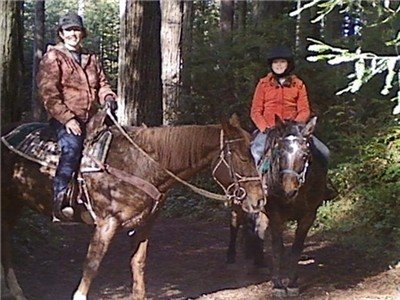
Horseback Trail Riding Uphill
When you are riding a horse up a hill, especially a steep one or a long climb, you will need to do all you can to make it easier on the horse. Lean forward. With the balls of your feet, use your stirrups to balance in this new forward leaning position. For very steep hills you will need to put your weight well over the horse’s shoulders and your stirrups may shift far to the back. This is ok. Many horses will try to run or lunge when going up a hill. When a horse lunges up hill it is very easy for them to pop you right off the back of the saddle. You may need to hold onto the horn to keep from slipping off the back. Use your reins to pull a lunging horse in. Make your horse walk it.
Horseback Trail Riding Downhill
When riding a horse down hill use your stirrups. Lean back and move your stirrups forward and place your weight on the balls of your feet. For very steep hills you may be leaning very far back and have your stirrups pointing toward the horse's shoulders. I have ridden down hills so steep the back of my head hit my horse’s rump! Give your horse enough rein so they can keep their balance and watch where they are putting their feet. You may find yourself having to outstretch your hand very far forward. If your horse tries to rush it, use the rein to pull them in and make them walk safely down.
Horseback Trail Riding and Water Crossings
If you do much trail riding at all, you’re bound to come across a water crossing. Choose a safe place to cross. Hopefully the trail will naturally bring you to the best crossing spot. Most trail horses will cross water without hesitation or they’ll cross when all the other horses have gone over and they don’t want to get left behind. After all, horses have a very strong herd instinct.
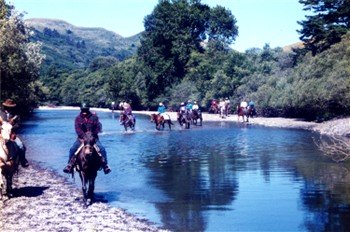
Give your horse plenty of rein so they can drop their head and choose their best footing. An experienced trail horse will watch where they place their feet. Your job it to stay balanced and let them do their work.
If you area passing a very wide shallow river, don’t look down at the water. Keep your eye focused on the shore ahead. Encourage your horse to keep their head up and moving forward. This is because the moving water can have a fun house effect, making both horse and rider dizzy! No joke, it’s happened to me. One of our mares got so dizzy another rider had to come in an help lead her out.
Horseback Trail Riding and Obstacles
An experienced trail horse will pay attention to where they are walking, but that does not mean you get to fall asleep in the saddle. Always watch the ground for hazards like holes, barbed wire or pieces of metal that have been abandoned (like car parts). You just never know what you’ll come across out on the trail. Also, it’s up to you to pay attention for low riding limbs and branches. Your horse will duck their head to avoid a low branch, but could care less if you get swept off the saddle.
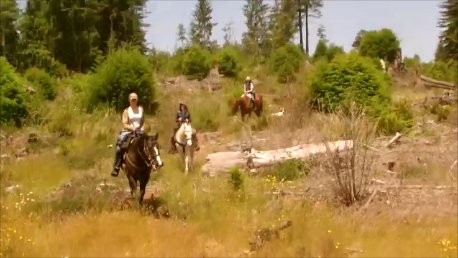
The horseback trail rider learns to expect the unexpected. I have run across teenagers racing on dirt bikes on a narrow trail at high speeds. You have to act quickly in a situation like that. There have been bears, cattle, snakes and elk. One time we came across a herd of Roosevelt Elk. The mare I was riding was so frightened by them I could feel her heart beating right through my saddle pads and my saddle! Luckily the Elk moved off and she settled right down. Come to think of it, that mare was afraid of cows too…..
When ever you come across an obstacle in the trail like a fallen log or large rocks or anything that requires your horse to place his feet well, let your horse have some rein so he can drop his head and pick the best route to take. Of course it's up to you, the trail rider, to use your best judgment and guide your horse when necessary.
Another Horseback Trail Riding Tip
Every horse, will at some point, be startled by something. Horses are prey animals and their instinct is to run away. When a horse is fearful they don’t think well. It’s your job to be the brains of the outfit. As a new rider you might be tempted to grab the saddle horn and hunch forward. This will throw you off balance. If you have read how to ride a horse, you will remember the part about keeping your heels pointed to the ground and sitting back. This will keep your butt firmly seated in the saddle. Pull back on the rein to bring your horse in. Talk out loud in a soft voice to your horse. It will help calm your horse and you too.
Even the best of trail horses will occasionally stumble. The natural instinct is to pull on the reins to make them stop the forward motion. Your horse will need to use his head and neck to regain his balance. Instead of pulling on the rein, you need to do the exact opposite and throw the reins forward to give your horse as much head as they need to catch their balance.
Horseback trail riding is one of life’s great pleasures. The horses enjoy it as much as the riders do. The trail rider often becomes insatiable; always looking for new trails, new places to discover and new adventures to be had. I myself, am hopelessly addicted to trail riding and I hope that you too discover the joy of horseback riding out in the natural world.
More Equine Topics You May Enjoy
Horse Keeping Cost
Cost to Own a Horse - Find out just how much is costs to own a horse form purchase price, to monthly expenses to incidentals. Find out what basic supplies you'll need.
